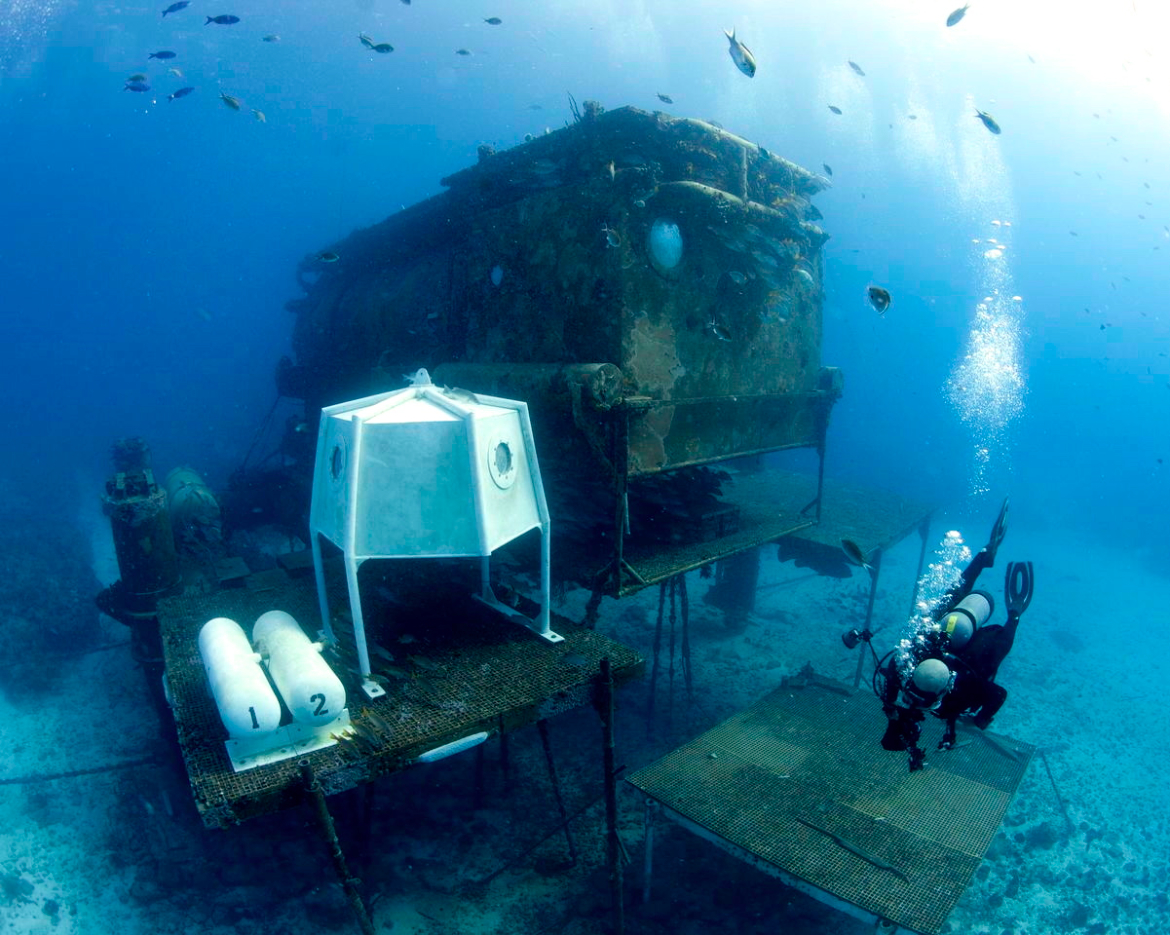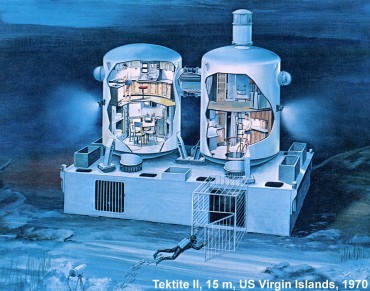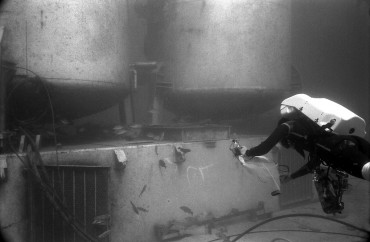Underwater habitats by dozens, just to see…
January 2014 – While walking next to the Seine in the heart of Paris, I could not stop thinking about all these pioneers that pushed the limits of what was possible for a man to do under the water, and whose names are known only by a handful of specialists and diving aficionados. How did this happen? Apart from Cousteau’s missions, it seems like all the other programs that followed fell into oblivion. Why didn’t we pursue this wonderful exploration of the underwater world that seemed so promising?
On this chilly morning of January, I am about to meet an American who will hopefully have some answers to my too many questions. William L. Todd had been part of the adventure, and surely his memory would hold some of the keys to understanding what happened.
“Bill” Todd is an American giant, towering at over 1,90 metres with broad shoulders and grey hair. He is an imposing figure who speaks with a surprisingly calm voice. His professional background is even more imposing than his stature: for many years he has been working as Program Manager for the NASA’s Johnson Space Centre in Houston, Texas. Todd trained and led many crucial space missions, including those for the international space station and the famous Hubble telescope.
But Bill Todd’s particularity is to have mixed space exploration with marine missions from an early stage. He worked on several projects of underwater habitats and has an extensive experience in operating submersible vehicles. In 2000, he launched the NASA program named “NEEMO” that stands for “NASA Extreme Environment Mission Operations”. In collaboration with the American agency for the oceans and the atmosphere, the NOAA, Todd trained and directed several teams of astronauts into various missions on the last remaining American underwater habitat: the Aquarius. When it comes to exploring new frontiers in space or in the marine environment, Todd knows what he is talking about.
Throughout our discussion, I quickly realize that the media attention that Cousteau benefited in his time did only cover a small fraction of what really took place in the history of underwater exploration.
“In parallel of the Cousteau’s “Conshelf” program, explains Todd, the US Navy kept on working on what Ed Link started with his “Man in the Sea” mission. The Navy later built what was called the “Sealab”, the first underwater laboratory.”
In 1964, one year after “Conshelf II” by Cousteau, “Sealab I” is immerged west of Bermudas, at the foot of a platform 60 metres deep in the Atlantic ocean. The underwater habitat built by the Navy bore a resemblance to a big cigar with metallic feet that had been dropped at the bottom of the sea. This first structure was 12 metres long for 3 metres in diameter. Then came “Sealab II” in 1965, followed by the launch of “Sealab III” in 1969. Unfortunately, in February of that same year, one of the aquanauts died from an injury caused by a human error. This put a momentarily stop to the US Navy’s underwater habitat program.
“Even if there was an evolution in size and complexity with each new version of the “Sealab”, the basic architecture and the principles remained very similar, explains Bill Todd. The budgets were on a shoestring, and the programs were kept as simple as possible. The aim at the time was essentially to know if it was possible to live below the surface of the sea. It was a time when many countries were fighting to be the first to proclaim “We managed to do it!” Although real breakthroughs were made in the technology used at the time and in the understanding of saturated deep diving, it is important to remember that no long term objectives were made for these habitats.”
Nevertheless, the 60’s and the 70’s saw the zenith of research in underwater habitat: in the US, “Hydrolab” was built in 1966, followed by “Tektite I” and “Tektite II” in 1969 and 1970; in 1968, the Soviets started their own program in the Black Sea, named “Chernomor”; in Japan, “Seatopia” was launched in 1969; that same year, the Germans colonized the depths of the North Sea with their “Helgoland”. In 1972, it’s Puerto Rico’s turn to inaugurate “La Chalupa”… Between 1962 and 1972, 63 official underwater habitats were tested in various seas and oceans. They were submerged at all kinds of depths, between 10 metres and 300 metres deep!
Although many countries developed their own missions, most of these habitats followed an identical building pattern: a thick metallic tube horizontally fixed to a structure at the bottom of the sea, where a mixture of different gazes was used to breathe. A pressurized mobile capsule was made to allow the descent and the ascent of the aquanauts, and a vessel or a platform would irremediably act as logistic support for the habitat. But one of these aquatic homes stood out with an unrivaled quality of equipment and comfort: the American program “Tektite”.
In the two years of 1969 and 1970, the NASA, the US Navy and General Electrics teamed up with the objective to design and build a proper underwater station. While on the “Tektite” program, the aquanauts could spend up to 58 days at a depth of 15 metres. For these missions, the design had somewhat evolved. Two cylinders measuring 4 metres in diameter and 6 metres high were connected by a flexible tunnel, the whole thing fixed to a rectangular metallic structure. This underwater habitat offered its occupants a relatively good comfort. Such is the memory that Jean-George Harmelin , a marine biologist that lived in “Tektite II” for 15 days in 1970, keeps to this day. “There was a room designed to enter the water that was well separated from the rest of the habitat, he recalls. It was a luxury that was definitely not available on all the other underwater programs. We used to live in the other rooms where all the modern comfort was available: four beds, a kitchen, an oven, a fridge, a television, a library, and the floor was even covered in carpet… To work underwater was a wonderful adventure that was indeed technically possible, but awfully expensive. I realized that these operations were a deluxe experience.”
Even though the technology was improving and the “Tektite” program was running smoothly, the experiences in underwater habitat were definitely showing their limits. The enthusiasm slowly decreased. But according to Bill Todd, the financial issue as well as the security norms that were implemented could have been overcome if the essential ingredient wouldn’t have been missing:
“All these underwater structures enabled man to step beyond the first stage, he explains. That is, the exploration’s stage. In order to get to the second stage, a question had to be answered: do we really want to live under the water? The underwater exploration lacked what John Fitzerald Kennedy provided to the conquest of space: a true political will. In his inaugural speech, JFK promised that man would one day walk on the moon. It was a very strong message. We tend to forget this, but the space program was very expensive. It also caused injuries and deaths, but they overcome all the problems and eventually a man walked on the moon because everyone who took part in that space program had a feeling of accomplishing something bigger than themselves. This was not the case with underwater habitats.”
Then, why give priority to the far away space when we have an immense unexplored world right here on Earth, on our doorstep? Moreover, a world from which life originated?
“It takes a different pair of philosophical glasses to understand that, explains Todd. When you are lying on the grass and looking at the sky, you can dream of flying all the way to the moon and walk on it. You can also perfectly imagine yourself sailing the oceans on a boat. But people can’t project themselves living below the surface of the oceans… as long as they haven’t been there themselves. This also explains why mankind is totally capable of fishing species to the point of extinction. It is another world. Literally out of sight, out of mind. It is as simple as that.”
The next chapter of this file will be published on Friday, September 19th 2014.
NOTA © The cover photo was taken by Stephen Frink








